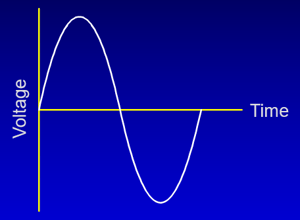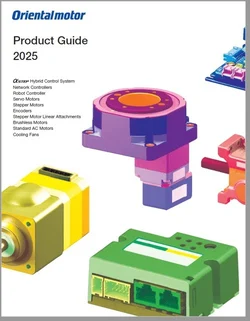For a permanent-split capacitor type AC motor (also known as capacitor start and run AC motors), a capacitor is required for proper operation. Enjoy a cup of coffee as we explain why.

A Simple Experiment...
To show how important a capacitor is, we can start with a simple experiment. Use a single-phase permanent-split-capacitor type AC motor and wire its lead wires directly to a single-phase power supply (skip the capacitor). The motor most likely won't run with the load unless the shaft is rotated by an external force (this is much easier with an ungeared, round-shaft motor). This is because we need at least two phases to generate a rotating magnetic field in the stator. This is where the capacitor comes in.
What does a capacitor do?
 |
Originally referred to as a "condenser", a capacitor is a passive electronic component that contains at least two conductors (plates) separated by an insulator (dielectric). The conductors can be thin films of metal, aluminum foil, or disks. The insulator can be glass, ceramic, plastic film, air, or paper. When connected to a voltage source, a capacitor stores an electrical charge in the form of an electrostatic field between its conductors. |
| Compared to a battery, a battery uses chemicals to store an electrical charge, and discharges it slowly through a circuit. This could take years. A capacitor releases its energy much more rapidly — in seconds or less. A common application example is the flash from your camera. |  |
| CAUTION: Since a capacitor holds an electrical charge, never touch the terminals of a capacitor. If you must for some reason, make sure that the electrical charge is completely discharged. |
What is the Purpose of the Capacitor for Motors?
The purpose of the capacitor is to create a poly-phase power supply from a single-phase power supply. With a poly-phase supply, the motor is able to:
1. Set the rotation direction.
2. Provide starting torque for the motor and increase torque during operation.
Oriental Motor's AC motors are all permanent-split capacitor type (capacitor start and run) motors. These motors contain a main winding and a secondary auxiliary winding. The capacitor is connected in series with the auxiliary winding, and this causes the current in the auxiliary winding to lag out of phase with the current in the main winding by 90 electrical degrees (a quarter of the entire cycle). Now we have created a poly-phase power supply from a single-phase power supply.
| Without a Capacitor | With a Capacitor |
 |
 |
What Kind of Capacitor Does Oriental Motor Use?
Oriental Motor employs vapor-deposition electrode capacitors recognized by UL. This type of capacitor uses a metallized paper or plastic film as an element. This capacitor is also known as a "self-healing (SH) capacitor". Although most of the previous capacitors used paper elements, the plastic film capacitor has become mainstream in recent years due to its compact design.
Rated Conduction Time
The rated conduction time is the minimum design life of the capacitor when operated at the rated load, rated voltage, rated temperature and rated frequency. The standard life expectancy is 40,000 hours. A capacitor that breaks at the end of life may smoke or ignite. We recommend that the capacitor be replaced after the rated conduction time to avoid potential issues.
Safety Feature of Capacitor
Some capacitors are equipped with a safety feature that allows for safe and complete removal of the capacitor from circuits to prevent smoke and/or fire in the event of a dielectric breakdown. Oriental Motor products use capacitors with UL recognized safety features that have passed the UL 810 requirement of a 10,000 A fault current test.
How are Capacitors Rated, and Why is This Important?
Capacitors are rated in capacitance, working voltage, tolerance, leakage current, working temperature, equivalent series resistance...etc. For the purpose of motor matching, the 2 most important specifications are capacitance and working voltage. The voltage rating is typically about double the value of the motor's rated input voltage in volts (there's actually a formula to determine the capacitance for a motor, but we'll save that for later). For our compact AC motors, the unit of measurement of the capacitance is "micro farad" or μF. These specifications are listed on both the motor label and the capacitor label.
| Motor Label with Recommended Capacitor | Capacitor Label |
 |
 |
The use of a capacitor with a different capacitance can increase motor vibration, heat generation, power consumption, torque variation, and unstable operation. If the capacitance is too high, motor torque will increase, but overheating and excessive vibration may occur. If capacitance is too low, torque will drop. Using a capacitor exceeding the rated voltage may cause damage and the capacitor may smoke or ignite.
Do I Need to Size the Right Capacitor For Oriental Motor's AC Motors?
No. Every single-phase AC motor from Oriental Motor includes a dedicated capacitor that is sized for the motor to operate at its highest efficiency and performance. No capacitor sizing is necessary.
What Happens If I Use a Different Capacitor?
To ensure that the motor is operating at its highest efficiency, always use the dedicated capacitor that is included with the motor. The dedicated capacitor creates a 90 electrical phase shift from the auxiliary (capacitor) phase to the main phase. Using the wrong capacitor can shift this away from the 90 degrees, and the resulting inefficiency can cause the motor to overheat with inconsistent torque or speed performance.

The dedicated capacitor is sized in order to have the motor produce this ideal torque/speed curve. Notice "Rated Speed" and "Rated Torque". This operating point (where these two intersect on the curve) is where the highest efficiency occurs. Every motor is designed for a rated load. This is why oversizing isn't the best way to size AC motors.
 |
 |
A difference in the capacitance in the capacitor will affect both rated speed and rated torque as the operating point shifts away from its maximum efficiency. If you use 2 of the same exact motors with vastly different capacitors, you will produce vastly different results.
Once maximum efficiency is lost, heat generation increases for the motor. Excessive heat can degrade bearing grease and decrease long term life of the motor. However, it's good to know that if the winding temperature reaches 130° F, the thermal protection circuit inside the motor will trip and shut off the motor until it's cooled down.
How Do I Wire a Capacitor?
For a 3-wire AC motor, connect the red and white lead wires to opposite terminals of the capacitor. Connect the black lead wire to N (neutral) side of the power supply. For unidirectional operation, just wire the L (live) side of the power supply to the terminal closet to either the red lead wire (clockwise) or the white lead wire (counterclockwise) to start rotation. HINT: the 2 closest terminals are joined internally. For bidirectional operation, use a single pole double throw (SPDT) switch in between the live wire and the capacitor terminals to switch direction.
However, to switch direction of an induction motor, you must wait until the motor comes to a complete stop. For reversible motors, the direction can be switched instantaneously.
 |
 |
Now that you know the importance of capacitors, don't lose them. If you do, use the motor label to identify the right capacitor to use. Stay tuned for more troubleshooting tips.
|
Related Resources: |






